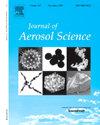氧化锌聚集体高速撞击的分子动力学研究
IF 3.9
3区 环境科学与生态学
Q2 ENGINEERING, CHEMICAL
引用次数: 0
摘要
尽管用于生产薄膜的干气溶胶沉积方法(气溶胶沉积、微冷喷雾和真空动力学喷涂)通常使用聚集或聚集的细粉末,但迄今为止,这些过程都是使用单颗粒撞击来模拟的。在本研究中,通过分子动力学模拟来研究更真实的ZnO聚集体高速撞击的情况。在这些模拟中,首先在三种温度下(1000°C, 1300°C和1500°C)对含有6个直径为10 nm的初级颗粒的聚集体进行退火,以诱导不同尺寸的颗粒间颈的生长,从而间接影响这些颗粒间颈的强度。然后对退火后的聚集体进行冲击,观察导致薄膜形成的变形机制。结果表明,聚集体内部的变形是由固态非晶化或熔化后发生的粘性流动驱动的,并由大的局部压力和加热驱动。颗粒间颈的大小/强度、冲击速度和骨料方向影响变形集中的方式,以及骨料能否在不破坏颗粒间颈的情况下耗散足够的动能沉积到基材上。本文章由计算机程序翻译,如有差异,请以英文原文为准。
A molecular dynamics study of high velocity impact of zinc oxide aggregates
Although dry aerosol deposition methods (aerosol deposition, micro cold spray, and vacuum kinetic spraying) for producing films typically utilize fine powders that are agglomerated or aggregated, to date these processes have been modeled using single particle impacts. In this study, molecular dynamics simulations were conducted to study the more realistic scenario where aggregates of ZnO were impacted at a high velocity. For these simulations, aggregates containing six primary particles with a diameter of 10 nm were first annealed at three temperatures (1000 °C, 1300 °C, and 1500 °C) to induce growth of interparticle necks with varying sizes and therefore indirectly affect the strengths of these interparticle necks. The annealed aggregates were then impacted to observe the deformation mechanisms that contribute to film formation. The results suggest that deformation within the aggregates is driven by viscous flow that occurs after solid state amorphization or melting and is driven by large, localized pressures and heating. The size/strengths of the necks, impact velocity, and aggregate orientations affect how deformation is concentrated and whether the aggregate can dissipate sufficient kinetic energy to deposit onto the substrate without fracturing the interparticle necks.
求助全文
通过发布文献求助,成功后即可免费获取论文全文。
去求助
来源期刊

Journal of Aerosol Science
环境科学-工程:化工
CiteScore
8.80
自引率
8.90%
发文量
127
审稿时长
35 days
期刊介绍:
Founded in 1970, the Journal of Aerosol Science considers itself the prime vehicle for the publication of original work as well as reviews related to fundamental and applied aerosol research, as well as aerosol instrumentation. Its content is directed at scientists working in engineering disciplines, as well as physics, chemistry, and environmental sciences.
The editors welcome submissions of papers describing recent experimental, numerical, and theoretical research related to the following topics:
1. Fundamental Aerosol Science.
2. Applied Aerosol Science.
3. Instrumentation & Measurement Methods.
 求助内容:
求助内容: 应助结果提醒方式:
应助结果提醒方式:


